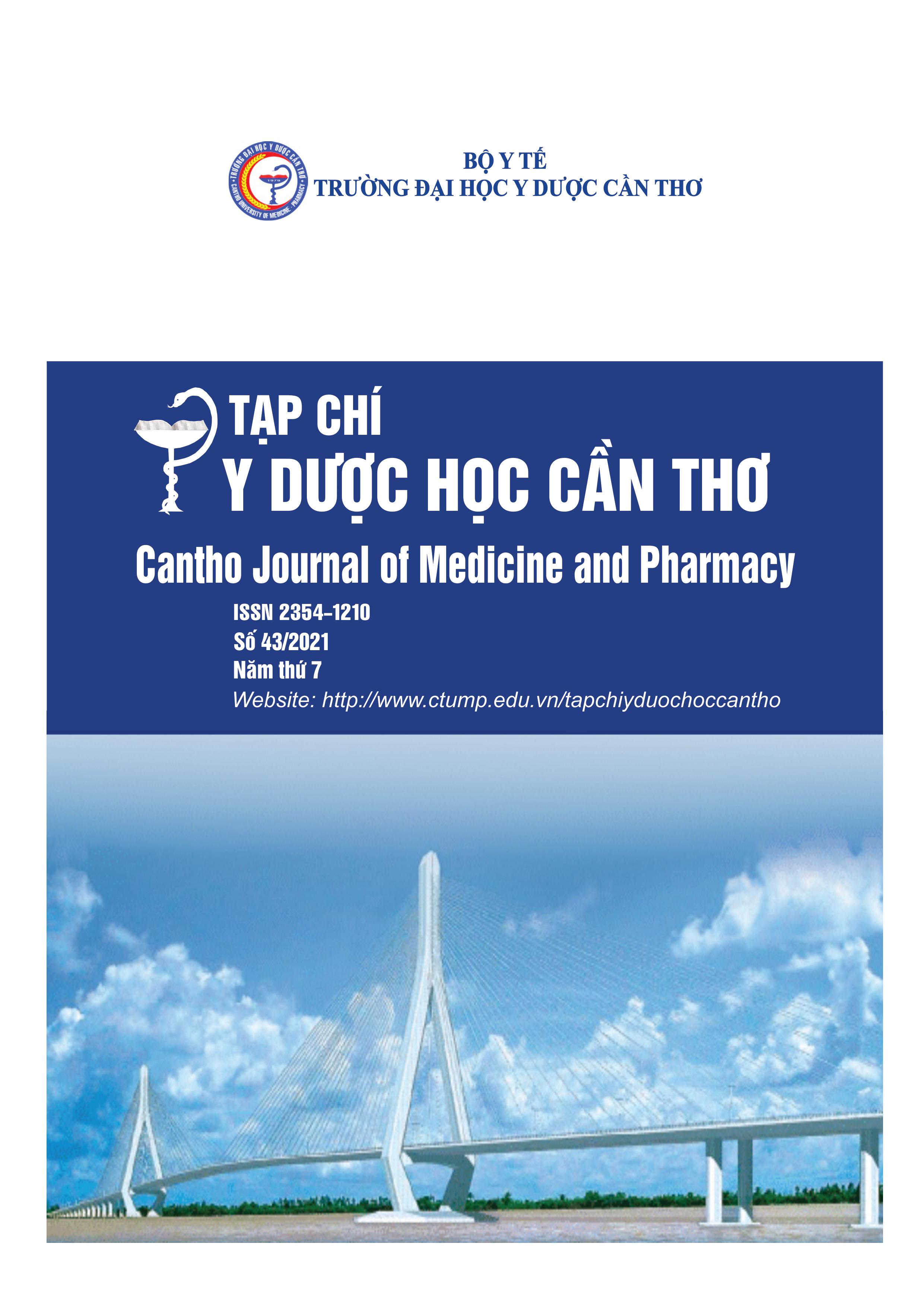ASSESSMENT OF THE TREATMENT EFFECTS OF THE BISMUTHCONTAINING QUADRUPLE REGIMEN IN HELICOBACTER PYLORI INFECTION ON GASTRITIS AND PEPTIC ULCER PATIENT AT CAN THO UNIVERSITY OF MEDICINE AND PHARMACY HOSPITAL IN 2020-2021
Main Article Content
Abstract
Background: Helicobacter pylori infection is one of the most common causes of gastritis and peptic ulcer disease. Bismuth-containing quadruple regimen is recommended selection as firstline therapy for patients with Helicobacter pylori infection in areas with high clarithromycin rates resistance. Currently, in the Mekong Delta, there have been microscopic researches on the result of this regimen on Helicobacter pylori infection treatment, especially in Can Tho city. Objectives: To evaluate the treatment effects of the Bismuth-containing quadruple regimen for treating gastritis and peptic ulcer disease of Helicobacter pylori infection. Materials and methods: A cross-sectional descriptive was conducted on 75 patients gastritis and peptic ulcer disease of Helicobacter pylori infection conducted at Internal Medicine Clinic, Can Tho University of Medicine and Pharmacy Hospital from May 2020 to May 2021. All patients have treated Bismuth-containing quadruple regimen (RBMT) for 14 days. From four to eight weeks after the completion of therapy, Helicobacter pylori infection status was rechecked by rapid urease test or C13 urea-breath test. Results: The HP eradication success rate was 94.7%, the failure rate was 5.3%. The rate of successful eradication of HP in groups under 40 years old, 40-59 years old and ≥ 60 years old were 100%, 96.3% and 72.7%, respectively. The difference in HP eradication rate in these three groups was statistically significant (p=0.004). Side effects occurred in 16%. The common side effects were nausea, headache and diarrhea. Conclusion: Bismuth-containing quadruple regimen achieved very high eradication rates. Side effects were uncommon but not severe.
Article Details
Keywords
Bismuth-containing quadruple regimen, eradication, Helicobacter pylori infection
References
2. Lương Quốc Hùng, Phạm Văn Lình, Kha Hữu Nhân (2019), Nghiên cứu đặc điểm lâm sàng, nội soi ở bệnh nhân loét dạ dày - tá tràng có Helicobacter pylori dương tính tại Bệnh viện Đa khoa Trung ương Cần Thơ, Tạp chí Y Dược học Cần Thơ, 20, tr.22-28.
3. Trần Văn Huy (2019), Nghiên cứu kết quả điều trị tiệt trừ Helicobacter pylori bằng phác đồ bốn thuốc có Bismuth cải tiến RBMA 14 ngày ở bệnh nhân viêm dạ dày mạn, Tạp chí Y Dược học - Trường Đại học Y Dược Huế, 9(2), tr.28-32.
4. Trần Văn Huy, Nguyễn Thị Minh Triều (2016), Nghiên cứu kết quả điều trị của phác đồ
RBTM ở bệnh nhân viêm dạ dày mạn có Helicobacter pylori dương tính, Tạp chí Y Dược học, 6(3), tr.31-35.
5. Nguyễn Thanh Liêm (2020), Ảnh hưởng của kiểu gen CYP2C19 đến tỷ lệ tiệt trừ nhiễm Helicobacter pylori ở bệnh nhân loét tá tràng bằng phác đồ bốn thuốc Rabeprazol, Bismuth, Tetracycline và Tinidazole, Tạp chí Y - Dược quân sự, (3), tr.10-14.
6. Vũ Diễm My, Hoàng Thị Phương Chi, Bùi Hữu Hoàng, Đỗ Thị Thanh Thủy (2016), Khảo sát kiểu gen Cytochrome P450 3A4 Subtype 1B (CYP3A4*1B) trên bệnh nhân viêm loét dạ dày tá tràng, Tạp chí Y học Thành Phố Hồ Chí Minh, 20(1), tr.319-323.
7. Bùi Chí Nam, Nguyễn Thị Cẩm Tú (2016), Đánh giá hiệu quả điều trị diệt Helicobacter pylori bằng phác đồ PCA, PTMB, PLA, Tạp chí khoa học tiêu hóa Việt Nam, 9(45), tr.2851-2854.
8. Trần Thị Khánh Tường,Vũ Quốc Bảo (2017), Hiệu quả điều trị của phác đồ 4 thuốc có Bismuth trong điều trị nhiễm Helicobacter pylori, Tạp chí Y Dược học, Trường Đại học Y Dược Huế, 7(3), tr.29-34.
9. Bang Chang Seok, Lim Hyun, et al. (2020), Amoxicillin or tetracycline in bismuthcontaining quadruple therapy as first-line treatment for Helicobacter pylori infection, Gut Microbes,11(5), pp.1314-1323.
10. Eisig Jaime Natan, Rodriguez Tomás Navarro, et al. (2015), Standard Triple Therapy versus Sequential Therapy in Helicobacter pylori Eradication: A Double-Blind, Randomized, and Controlled Trial, Gastroenterol Res Pract, 2015, pp.1-5.
11. Kim So Jeong, Chung Jun - Wong, et al. (2019), Two-week bismuth-containing quadruple therapy and concomitant therapy are effective first-line treatments for Helicobacter pylori eradication: A prospective open-label randomized trial, World J Gastroenterol, 25(46), pp.6790-6798.
12. Yan Tian - Lian, Gao Jian - Guo, et al. (2020), Current status of Helicobacter pylori eradication and risk factors for eradication failure, World J Gastroenterol, 26(32), pp.4846-4856.


